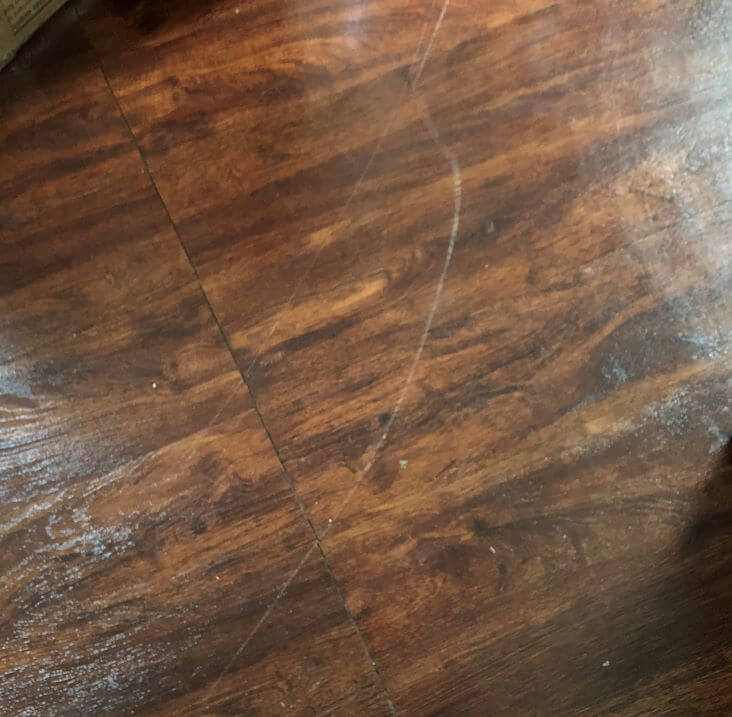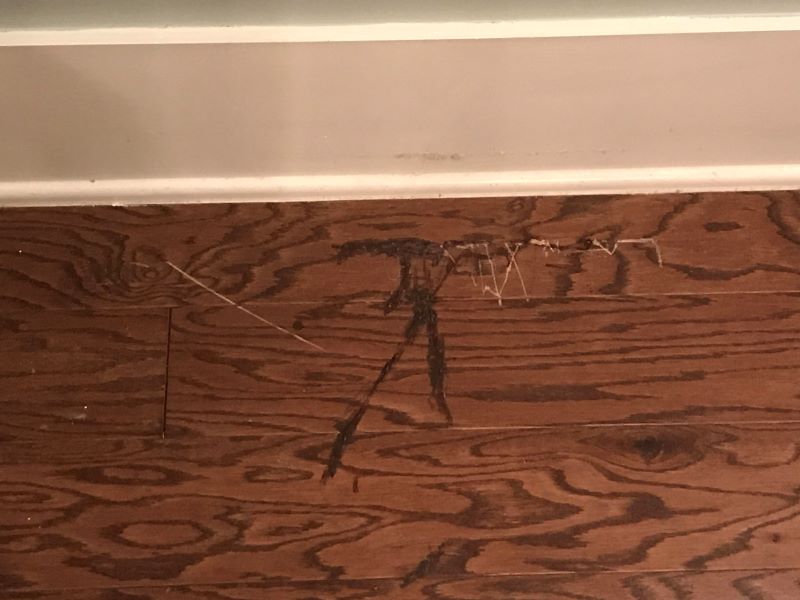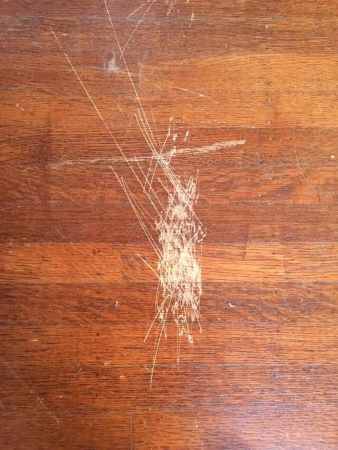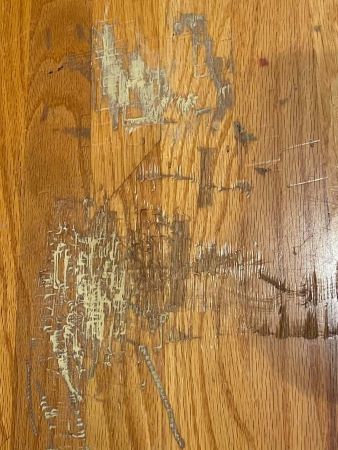The best laminate floors can represent quality meant to last. Thanks to their wear layer, they are not only resistant to fading from sunlight but are also resistant to wear and scratching.
However, no floor, irrespective of how expensive it is, is completely resistant to the claws of your furry friends, a fork being wielded by a toddler, or that huge bit of grit stuck beneath one of your preschooler’s sneakers.
Thankfully, minor scratches on your laminate floor do not have to be permanent. Here we will show you how to remove scratches from laminate flooring using simple techniques and inexpensive items which can have your surfaces looking just the way you love them, in no time at all.

How to Remove Scratches From Laminate Flooring
The first thing you will need to do before applying any of the options provided below is clean the affected area and leave it to dry.
Once your floor is ready, you will be able to use colored putty, pencils, markers, burn-in sticks, or even oil to get rid of the blemishes on your floor. The first three items are often provided as part of a laminate floor repair kit or can be purchased separately.
We have provided detailed steps on how to proceed below.
1. Burn-In Sticks
These products can be used for shallow scratches. However, they require a burn-in knife or flameless heat gun to melt them.
Once the tip starts to gleam, you will need to apply it to the scratch. You will then need to scrape off the excess with a hard flat object such as a credit card, and then buff your floor.
2. Colored Putty
This method is best used for removing scratches that are somewhat larger but do not necessitate the removal of the affected board.
You will need to apply some of the paste to the scratch you wish to conceal, using a putty knife.
You will also need to remove any excess quantities using the knife and then use a cloth to buff the floor.
3. Home Remedies
If you happen to be dealing with a particularly superficial scratch, you will be able to use some oil applied to a cloth to conceal it by rubbing it gently. Coconut or olive oil will be suitable in this instance.
4. Pencils and Markers
Options in this category are ideal for removing minor scratches. When using either option, you will need to ensure that the color is an exact match for your floor. You will then need to gently apply the pencil or the marker across the scratch until it is completely concealed.
Once it becomes indistinguishable from the rest of the plank, you will need to stop as continuing may leave a darker trace on the board. Finally, you will need to use a clean cloth to buff the floor.
(Both pencils and markers happen to contain the same material and are effectively the same thing in different forms.
Those used for wood floors will also work perfectly on your laminate floors and you will be able to use them instead if you already have one available in the color and shade that you need.)
5. Wax Sticks
This alternative is ideal for the deepest scratches on your laminate floors. It is actually possible to mix colors when using them to obtain the perfect hue for your floor.
Once you have gotten the color you want, you will simply need to apply the product you have purchased following the manufacturer’s instructions and wait for it to dry.
6. Replace Affected Planks
If the scratch happens to be particularly deep, you may need to remove the affected planks and replace them with alternatives from your surplus supply.
You will be able to do so by removing the base molding, working your way toward the damaged plank, and removing the other boards in front of it. You will also need to replace it with a brand new board and replace the other planks which are in excellent condition, and finally, put back the base molding.
If you happen to have glued your planks, you may need to cut out the damaged board. However, it is worth noting that a fair amount of skill will be required to do so and you may need to call on a professional to carry out the procedure.
Best Laminate Flooring Scratch Removers
There are several products in this category that can be used to restore a uniform, even appearance to your laminate floors. Some of the most effective of them have been provided below:
1. Katzco Repair Kit
This wax stick and marker laminate floor set comes with an impressive variety of colors that you will be able to blend to obtain the ideal hue for your floor. (The manufacturer has also provided a color matching guide to assist you in this regard.)
The markers are quick drying ensuring the process of repairing scratches will be completed as soon as possible, providing you with an even, scratch-free surface.
Just small quantities are needed, ensuring you will be able to make use of it for as long as possible, and any repaired spots will be virtually indistinguishable from the rest of the floor.
2. Fortivo Repair Kit
With this repair kit consisting of putty and stains, you will be able to take care of moderate scratches on your laminate surfaces.
Color matching support is also provided to ensure you get it perfectly right.
There are also clear tips provided by the instruction manual, which will enable you to take the right steps towards achieving a floor that seems almost brand new.
3. Mohawk Quick Fill Burn-in Stick
This burn-in stick is nimble enough to get into small cracks once heated. It will also set impressively firmly as well once it has cooled. You will also be able to remove any surplus with ease using a credit card.
Special care should be taken to select the right color before purchasing.
How to Prevent Scratches on Laminate Flooring
Protective measures can go a long way towards preserving the sheen of your laminate floor and preventing the occurrence of scratches which can mar its elegance.
Here are a few cost-effective methods that will enable you to protect your floors:
1. Using Rugs and Runners
These features are great for enabling your laminate floors to better handle the inevitable wear and tear of high traffic areas, energetic kids, and playful pets.
What’s more, they can also serve to enhance your decor ensuring you get to enjoy additional benefits for placing them around your home.
2. Doormats
Placing doormats outside and inside entrances to your home can protect your floors. External rugs will remove most of the grit and those used in the interior will protect your floors from any lingering debris, while also serving as a spot at which visitors and residents alike can leave their footwear.
3. Furniture Protection Pads
Placing felt furniture protection pads beneath the legs of your tables, stools, and chairs can significantly reduce the risk of scratches and dents on your laminate floors. Heavy-duty felt pads with a firm adhesive grip are highly recommended.
However, the presence of these pads does not mean that you should permit your furniture to be dragged rather than lifted.
(Furniture protection pads should also be replaced three times a year.)
Conclusion
Owing to an abundance of cost-effective remedies, scratches on laminate floors happen to be an issue that is generally easy to resolve.
Taking protective measures as an extra precaution can also go a long way in reducing the risk of such blemishes affecting the surfaces in your home, ensuring they can effectively enhance the elegance of your living space, as a result.





